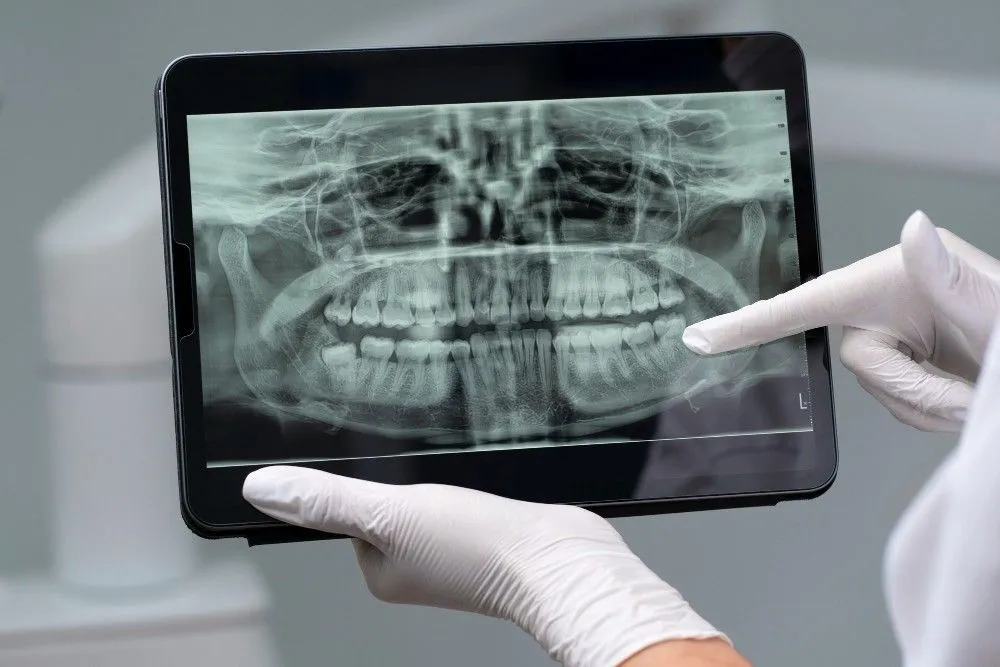Straight teeth and a big smile can positively impact the confidence and well-being of a person. So if you are struggling with crooked teeth and are unconfident about your smile, Invisalign can be the best alternative to traditional metal braces which can help straighten your teeth and improve your smile. However, seeing Invisalign as the new dental treatment, you might be wondering, “How does Invisalign work?” Well, it provides a more comfortable way to arrange your teeth in line using an innovative 3D imaging technology using invisible aligners. This left you with well-aligned teeth and a lovely smile. If you are curious to know how it works, here we have curated a blog to guide you on the detailed Invisalign process. Additionally, we will cover what Invisalign is, what dental issues it fixes, its work, how long it takes to work, its benefits, and many more facts. Let’s jump directly into an Invisalign world!
What Is Invisalign?
Invisalign is a well-known modern orthodontics treatment that makes use of custom-made and invisible aligners to slowly move your misaligned teeth into the right positions. This treatment has shown effective results for over 14 million patients. Unlike traditional braces that work with wires and brackets, Invisalign aligners use only invisible and smooth plastic material. With these aligners, you can fix the position of your teeth without any hassle or inconvenience. As this treatment proceeds, you have to refill the aligners in a few weeks. The important benefit of Invisalign aligners is they are removable. You can conveniently take them off when you want to brush, eat, floss, or drink. This makes easy maintenance of oral hygiene which is a little bit challenging in metal braces.
What Kinds Of Dental Issues Does Invisalign Correct?
Invisalign treatment can fix crowding, spacing, and mild to moderate bite issues. It can be used to correct the following dental problems:
- Overbite: Upper teeth overlap the lower ones.
- Crossbite: Upper teeth sit inside the lower teeth when biting down.
- Underbite: Lower teeth protrude beyond the upper teeth.
- Gap between teeth: Spaces between teeth due to alignment issues.
- Crowded teeth: Insufficient space causing teeth to overlap or twist.
- Rotated teeth: Teeth that are turned or twisted out of alignment.
- Open bite: Upper and lower teeth do not touch when biting down.
How Does Invisalign Work?
So, how well does Invisalign work? Invisalign works by gently putting pressure and shifting the misaligned teeth together with the periodontal membrane present between teeth into an accurate position. The force pushes the gum tissues to lower and then again takes up the place in the membrane on the area where the pressure is applied. In turn, by moving the particular tooth, the new tissues form in the left space. As the teeth start to shift, the aligners will also move out of their place. This means you need to wear a new set of aligners every 1 to 2 weeks. The important factor to keep in mind to make sure the effectiveness of the Invisalign is wearing the aligners each day for almost 20 to 22 hours, a study says. Want to know about the mechanism of the Invisalign process? Take a look!
1. Initial Consultation
This is the first step of Invisalign treatment where dentists examine your teeth to determine if this treatment will be effective for you. If yes, professionals will take your teeth’ pictures, X-rays, and impressions to create an innovative 3D model of your mouth.
2. Custom Treatment Plan
Once the doctor properly examines all your dental needs, they will use Invisalign's proprietary software to devise a custom treatment plan. The software helps imitate the teeth' movement from their existing to the right position. With this, you can see a digital representation of all your final fixed straight teeth.
3. Aligner Fabrication
With the help of a custom treatment plan, dentists customize sets of clear plastic aligners. Each aligner is a little different from each other and is worn for 2 weeks. During this period, aligners slowly shift the teeth close to the final target as per the designed treatment plan.
4. Wearing Aligners
Just after the aligner fabrication procedure, dentists will provide the aligner trays that you can start wearing. These aligners need to be worn for about 22 hours every day. You can take them off while brushing, eating, and flossing. For every 2 weeks, doctors ask to change the aligners. This, in turn, allows the gradual shift of the teeth.
5. Regular Check-Ups
Once you start wearing the aligners, you will have to regularly visit the dentist to monitor treatment progress. At each schedule, the doctor will assess the movement of your teeth and change the treatment plan.
6. Finishing Treatment
As you are done with your final aligner set, your Invisalign treatment is complete. Your doctor may advise you to wear the retainers to maintain the position of new straight teeth.
Now, curious to know, “How fast does Invisalign work”? Well, Invisalign fixes your misaligned teeth and enhances your smile in around 12-18 months which may vary according to the dental issues of an individual. Let’s discuss it in detail in the section below!
How Long Does It Take For Invisalign To Work?
Wondering how fast does Invisalign work? The time taken by Invisalign can vary based on the dental conditions of a person. Those dental conditions may include overly crowded teeth, gapped teeth, rotated teeth, etc. In general, it might take around 8 to 10 months. Research says the short duration for the Invisalign treatment can be 6 months to fix the dental issues. In a complicated situation, it might take 24 months to reach the desired target. Remember that, it is essential to visit your doctor to know the accurate time based on your specific dental needs. On the other hand, if you want to know “How long does it take for Invisalign to start working”, well, you will notice a little shift within 2 weeks. But, most people can experience an improvement in 3-5 months.
What Are The Benefits Of Invisalign?
Invisalign is a clear and bracket-free orthodontic treatment that has much to offer including:
- Aesthetics: This is the most significant benefit of Invisalign which helps maintain your beautiful smile with aligners on. The Invisalign aligners are transparent, making them invisible.
- Comfort: These aligners are designed using smooth plastic which is comfortable to wear and won’t hurt your gums, cheeks, or other soft mouth tissues.
- Removability: The best advantage is its removability. You can remove these dental appliances while eating food and brushing. Along with fixing your teeth, this benefit also helps maintain your overall oral health.
- Predictability: As Invisalign aligners are customized using 3D technology, this means you are ensured about the certainty of results. This also lowers the need for regular visits to modify the aligners.
How Much Does Invisalign Treatment Cost?
As Invisalign treatment is a customized plan, the cost for each individual will vary. On average, the price may range from $3,000 to $5,000. However, a simple treatment may cost less. Also, the estimation of the cost can be determined based on:
- The complexity of your dental condition.
- The length of the treatment.
- The doctor you select for the treatment.
In case, you have a dental insurance plan, you can easily pay some amount for treatment using it. If you do not have any insurance, many dentists provide payment plans for the services they offer. Make sure to discuss them with the doctors before the treatment.
Is Invisalign Right for You?
Invisalign has become the better alternative to traditional metal braces, specifically for the one looking for a more careful dental treatment. However, it may not be the right option for every individual. As Invisalign treatment needs a strong consistency to wear the aligners for about 22 hours a day, people finding challenges in maintaining good oral health may experience some issues. The problems may arise because they need to take off the aligners more often to clean their teeth. For severe dental correction, traditional metal braces are the only option. In case you have any doubts about determining which treatment is suitable for you, it is best to seek help from a licensed dentist, who treats special cases and assists with special guidance on the right treatment option. You can also read our comparative guide on Braces vs Invisalign: Which is Better?
Summing Up
We learn in this article how does Invisalign work. Invisalign works effectively and gently to move the teeth into the right position without any inconvenience like traditional braces. It offers a creative solution to fix your teeth and achieve an appealing smile. Throughout this article, we have discussed what kinds of dental issues Invisalign corrects, its treatment process, its benefits, and the treatment cost. If you want to change your smile, we encourage you to consult the experienced team who will help customize the treatment plan to meet your dental needs.
Frequently Asked Questions
How does Invisalign work for overbite?
Invisalign can work for overbite by shifting the teeth. It takes about 12-24 months which depends on the severity of the case.
How does Invisalign work faster than braces?
Invisalign works faster compared to braces as the aligner trays are customized and require to be changed during the treatment so that they always work to improve your misaligned teeth.
How does Invisalign work for crowded teeth?
Invisalign aligners work by moving the crowded teeth to their right position in around 2 years. During this period, you need to replace the aligners with a new set.
How does Invisalign work for gaps?
Invisalign may fix teeth gaps issue by moving the teeth’ position over time. It might take 3-6 months to treat this problem.
How long does it take for Invisalign to start working?
It might take time for most people, some start experiencing the transformation within 2 weeks. Others may have to wait for 3 or 5 months to notice any improvement.
How does DSD work with Invisalign?
DSD (Digital Smile Design) collaborates with Invisalign and adds a smile design that the DSD creates with the customized treatment plan. This collaboration eases the movement of teeth which helps create a beautiful smile.
Reviewed by







